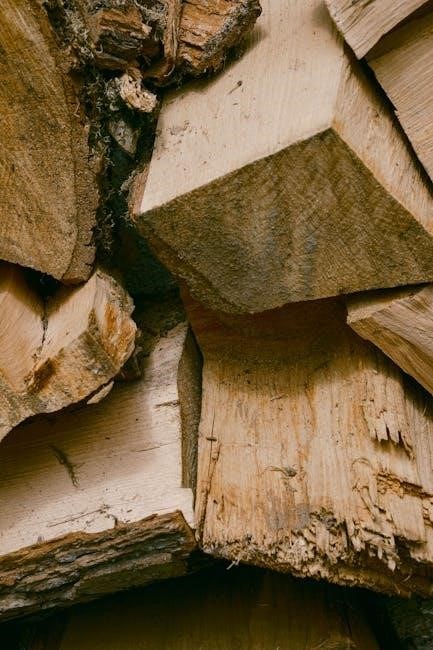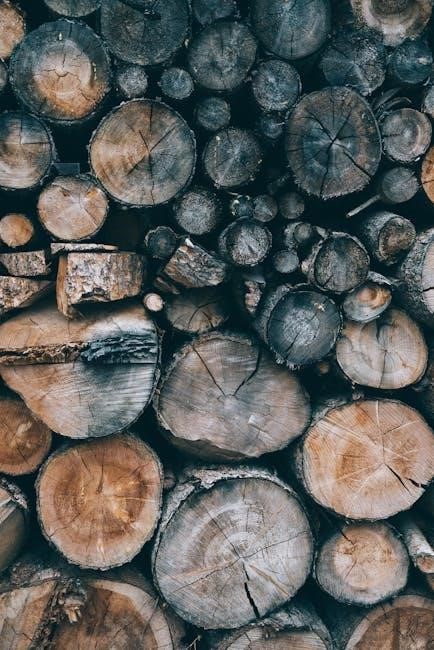Firewood BTU charts are essential for comparing the energy content of different wood types, offering insights into BTU per pound and factors affecting heat output, helping users optimize their heating efficiency.
What is BTU in the Context of Firewood?
BTU, or British Thermal Unit, measures the energy content of firewood, indicating how much heat it can produce when burned. Higher BTU values mean greater heat output. Firewood BTU ratings are typically expressed per pound or per cord, with non-resinous woods like ash and maple ranging from 8,000 to 8,500 BTU per pound, while resinous woods like pine and fir range from 8,600 to 9,700 BTU per pound. These values help compare different firewood types and their heating efficiency, allowing users to make informed decisions for optimal heat production. BTU charts provide a standardized way to evaluate firewood quality and energy potential, ensuring efficient use of resources for heating needs.
Importance of BTU Ratings for Firewood
BTU ratings are crucial for evaluating firewood’s heating potential, helping users determine which types provide the most heat per unit. Higher BTU content ensures more efficient combustion, reducing the need for frequent refueling. Understanding BTU ratings allows consumers to compare firewood species, such as hickory and oak, which are known for their high BTU values. These ratings also guide decisions on storage and seasoning, as moisture significantly impacts BTU content. By prioritizing firewood with higher BTU ratings, users can achieve better heat output while minimizing waste. This makes BTU ratings indispensable for optimizing heating efficiency and cost-effectiveness, especially in regions where firewood is a primary heat source. Accurate BTU ratings help in making informed purchasing and usage decisions, ensuring reliable and efficient heating performance throughout the season.

Understanding Firewood BTU Ratings
Firewood BTU ratings measure energy content per pound, varying by species, moisture, and density, helping users evaluate heat efficiency and choose optimal firewood for their needs effectively.

Factors Affecting BTU Content in Firewood
The BTU content in firewood is influenced by several key factors, including moisture content, wood species, and density. Moisture plays a significant role, as higher moisture levels reduce BTU efficiency. Wood species vary in energy density, with hardwoods like hickory and oak generally offering higher BTU values than softwoods like pine. Density also impacts heat output, as denser woods burns longer and produces more heat. Understanding these factors helps consumers make informed decisions when selecting firewood for optimal heating performance and efficiency. These variations are clearly outlined in firewood BTU charts, providing a comprehensive guide for comparing different types of firewood based on their energy content and burning characteristics. By considering these factors, users can maximize their heating needs and ensure they are getting the best value for their firewood.
Moisture Content and Its Impact on BTU
Moisture content significantly affects the BTU of firewood, as higher moisture levels reduce its energy efficiency. According to recent data, firewood with 20% moisture content has an average caloric value of 6450 BTU per pound. When moisture increases, the energy required to evaporate water reduces the actual heat produced. For instance, green wood with high moisture can have BTU values 20-30% lower than properly seasoned wood. This emphasizes the importance of seasoning firewood to achieve optimal BTU performance. Charts and guides, such as those found in firewood BTU chart PDFs, often highlight the impact of moisture, providing a clear comparison between green and dry wood. Properly dried firewood ensures higher heat output and more efficient burning, making it a crucial factor for users seeking maximum heating value from their firewood.
Wood Species and BTU Variations
Different wood species exhibit varying BTU content, influencing their heat output. Hickory, for example, has a high BTU rating of 4327 per pound, making it a top choice for efficient heating. Oak, both white and red, offers reliable BTU values, ranging between 27.7 and 30 million BTUs per cord. Maple and ash also provide substantial heat, with BTUs around 26.5 and 26.8 million per cord, respectively. In contrast, softwoods like pine and spruce tend to have lower BTU ratings, typically between 14.7 and 16.7 million BTUs per cord. These variations are well-documented in firewood BTU chart PDFs, which list species-specific data to help users select the best firewood for their needs. Understanding these BTU differences allows consumers to make informed decisions, ensuring they achieve optimal heat output and efficiency from their firewood.
Density of Wood and Its Relation to BTU
Wood density plays a significant role in determining BTU content, as denser woods generally produce more heat. Higher-density species like hickory and beech have BTU ratings around 4327 and 3890 per pound, respectively, due to their compact structure. Conversely, less dense woods such as pine and spruce have lower BTU values, typically ranging from 14.7 to 16.7 million BTUs per cord, as they contain more airspace. Density directly correlates with energy content, meaning denser wood burns slower and releases more heat. This relationship is crucial for understanding why certain species are preferred for efficient heating. Firewood BTU chart PDFs often highlight these density-related variations, helping users identify the most efficient options for their needs. By prioritizing dense woods, individuals can maximize their heating output and achieve better fuel efficiency.

Firewood BTU Chart by Species
Firewood BTU chart lists BTU content per species, comparing heat energy of hardwoods and softwoods. Hickory, oak, and maple have higher BTU ratings, while pine and spruce are lower. This chart helps users choose the best firewood for efficient heating by organizing data clearly.
Hickory (Shagbark) BTU Ratings
Hickory, particularly the Shagbark variety, is renowned for its high BTU content, making it a top choice for firewood. With an average BTU rating of 4,327 per pound and 27.7 million BTUs per cord, it outperforms many other species. Its dense structure and low moisture content when properly seasoned contribute to its exceptional heat output. Hickory burns slowly and produces a intense, long-lasting heat, ideal for home heating. The high energy content also means less wood is needed to achieve the same warmth compared to lower BTU species. Its popularity stems from its reliability and efficiency, making it a favorite among firewood enthusiasts. Proper seasoning is key to maximizing its BTU potential, ensuring it burns cleanly and effectively. Overall, Shagbark Hickory is a superior option for those seeking high heat output from their firewood.
Oak (White and Red) BTU Ratings
Oak, both White and Red, is highly regarded for its robust BTU ratings, making it a popular choice for firewood. White Oak typically offers around 30 million BTUs per cord, while Red Oak provides slightly less at approximately 28 million BTUs. These values translate to about 4,000 to 4,500 BTUs per pound when seasoned properly. Oak’s dense wood structure and relatively low moisture content contribute to its high heat output, ensuring efficient burning. It burns steadily and produces consistent warmth, making it ideal for long-term heating needs. Additionally, Oak is abundant in many regions, making it a readily available option. Proper seasoning is crucial to unlock its full BTU potential, as green Oak can have higher moisture levels that reduce efficiency. Overall, both White and Red Oak are excellent choices for those seeking reliable and high-quality firewood.
Maple BTU Ratings
Maple firewood is known for its reliable heat output, with BTU ratings averaging around 26.5 million BTUs per cord when properly seasoned. On a per-pound basis, Maple typically ranges between 3,900 to 4,200 BTUs, making it a solid choice for efficient burning. Its moderate density and relatively low moisture content contribute to a steady, consistent burn. Maple is a hardwood that burns cleanly, producing minimal smoke and creosote buildup, which makes it a popular option for both fireplaces and wood stoves. While it may not reach the peak BTUs of Hickory or Oak, Maple’s balanced heat output and availability make it a practical and effective firewood choice for many users. Proper seasoning is key to maximizing its BTU potential and ensuring optimal performance.
Ash BTU Ratings
Ash firewood is a highly efficient option, offering BTU ratings around 26.5 million per cord when properly seasoned. On a per-pound basis, Ash typically ranges between 3,900 to 4,200 BTUs, making it a reliable choice for heat production. Known for its moderate density and relatively low moisture content, Ash burns cleanly and consistently, producing minimal smoke and creosote buildup. It is a hardwood that ignites easily and burns steadily, making it ideal for both fireplaces and wood stoves. Ash is also versatile, as it can be burned both green and seasoned, though seasoning significantly enhances its BTU output. Its balanced heat output and ease of splitting contribute to its popularity among firewood users. Overall, Ash is a practical and efficient firewood choice, providing consistent warmth with proper seasoning and storage;
Beech BTU Ratings
Beech firewood is a popular choice for heating, offering a BTU rating of approximately 26.8 million per cord when seasoned. On a per-pound basis, Beech typically ranges between 3,800 to 4,000 BTUs, making it a reliable option for consistent heat output. Known for its dense hardwood composition, Beech burns slowly and produces a long-lasting flame, ideal for colder climates. It also has a moderate moisture content when properly seasoned, which enhances its efficiency and reduces smoke production. Beech is relatively easy to split and ignites quickly, making it a practical choice for both fireplaces and wood stoves. Its balanced heat output and durability contribute to its popularity among firewood users. Overall, Beech is a solid option for those seeking a dependable and efficient firewood solution, especially when seasoned to optimal moisture levels.
Birch (Black) BTU Ratings
Black Birch firewood is recognized for its high heating value, offering around 26.8 million BTUs per cord when properly seasoned. On a per-pound basis, it typically ranges between 3,800 to 4,000 BTUs, making it a strong contender for efficient heat production. Known for its dense hardwood, Black Birch burns steadily and provides a long-lasting flame, ideal for colder environments. It has a moderate moisture content when seasoned, which enhances its burn efficiency and reduces smoke. Black Birch is relatively easy to split and ignites quickly, making it a practical choice for both fireplaces and wood stoves. Its balanced heat output and durability make it a favorite among firewood users. Overall, Black Birch is a reliable and efficient option for those seeking consistent heat, especially when seasoned to optimal moisture levels.
Pine BTU Ratings
Pine firewood typically offers lower BTU ratings compared to hardwoods, with an average of around 16.7 million BTUs per cord, depending on species and moisture content. On a per-pound basis, it ranges between 6,500 to 7,600 BTUs, making it less energy-dense than hardwoods like oak or maple. However, pine is widely available and often more affordable, making it a popular choice for kindling or short-term heat needs. Pine contains resin, which can produce more creosote buildup in chimneys, requiring more frequent maintenance. Despite its lower BTU content, pine can still provide effective heat when properly seasoned, though it burns faster and less efficiently than denser woods. For optimal performance, it’s best to mix pine with higher BTU wood types to balance heat output and burn time.
Spruce BTU Ratings
Spruce firewood generally has lower BTU ratings, averaging around 15-17 million BTUs per cord, with a per-pound BTU range of 5,500 to 7,300. It is comparable to pine in energy content but slightly less dense. Spruce is often mixed with other softwoods for better heat output but burns quickly and produces less sustained heat. Its lower BTU content makes it less ideal for long-term heating needs. However, spruce is readily available and affordable, making it a practical choice for supplemental heating. Proper seasoning is crucial to enhance its burn efficiency and reduce smoke production. While not the most efficient firewood, spruce can be effective when used in combination with higher BTU wood species for a balanced heating approach.
Fir BTU Ratings
Fir firewood typically has relatively low BTU ratings, averaging around 15-16 million BTUs per cord, with a per-pound BTU range of 5,500 to 7,000. It is similar to spruce in energy content and burns relatively quickly, producing less intense heat. Fir is often mixed with other softwoods to improve burn efficiency but may produce more creosote buildup in chimneys due to higher resin content. Seasoning fir thoroughly is essential to reduce moisture and enhance its heating performance. While fir is not ideal for primary heating needs, it can be a cost-effective option for supplemental use. Its availability and affordability make it a common choice for short-term heating solutions, though it may not provide the same longevity as denser hardwoods like oak or hickory.
Ironwood BTU Ratings
Ironwood, often referred to as Hop Hornbeam, stands out for its exceptional BTU ratings, making it one of the most efficient firewood choices. With an average BTU rating of 26.8 million per cord, it surpasses many hardwoods in heat output. Its BTU per pound ranges from 4,000 to 4,300, indicating high energy density. Ironwood burns slowly and produces a consistent, long-lasting heat, making it ideal for extended heating needs. Its dense hardwood composition ensures minimal moisture content when properly seasoned, further enhancing its performance. However, ironwood can be challenging to split and may require more effort to ignite. Despite these challenges, its superior BTU ratings make it a favorite among those seeking reliable, high-energy firewood for colder climates and prolonged heating sessions.

How to Read a Firewood BTU Chart
Understanding BTU charts helps compare firewood efficiency, showing BTU per pound and per cord, allowing users to select optimal wood for their heating needs effectively and efficiently.
Understanding BTU per Pound and BTU per Cord
BTU per pound measures the energy content of firewood, with hardwoods like hickory typically ranging from 8,000 to 9,700 BTU/lb, while softwoods have slightly lower values. BTU per cord calculates the total energy in a full cord of wood, considering both the wood species and its moisture content. Higher BTU per cord indicates more heat potential, making it crucial for determining the best firewood for specific heating needs. These measurements help users compare different wood types and make informed decisions for optimal heating efficiency. By understanding these metrics, individuals can choose firewood that provides the most heat while minimizing waste and cost.

Interpreting Moisture Content in BTU Charts
Moisture content significantly impacts firewood’s BTU ratings, as higher moisture reduces energy efficiency. BTU charts often display values for wood at different moisture levels, such as 20% or 30%. Wood with 20% moisture typically has a BTU value of around 6,450 per pound, while kiln-dried wood with lower moisture can reach up to 8,600 BTU per pound. The charts help users compare how moisture affects heat output, emphasizing the importance of proper seasoning. For instance, a cord of oak with 30% moisture may yield 20 million BTUs, while the same cord at 20% moisture could provide 27 million BTUs. This highlights the need to prioritize drying firewood to achieve optimal BTU levels for efficient heating. Understanding moisture content in BTU charts ensures users select and prepare firewood effectively for maximum heat output.

Practical Applications of BTU Charts
BTU charts help users choose optimal firewood, calculate heat output, and ensure proper seasoning, making them essential for efficient and cost-effective heating solutions using firewood.
Choosing the Best Firewood for Your Needs
Choosing the best firewood involves analyzing BTU ratings, moisture content, and wood species. Hardwoods like oak and hickory generally offer higher BTU values, providing longer-lasting heat compared to softwoods like pine. BTU charts help identify species with optimal heat output, ensuring efficient burning. Moisture content is crucial; drier wood burns more efficiently, releasing maximum energy. By referencing BTU charts, users can select firewood that meets their specific heating needs, whether for a fireplace or wood stove. Seasoned wood, with lower moisture levels, is recommended for higher BTU output. This informed selection process enhances heating performance and reduces waste, making BTU charts an invaluable resource for firewood enthusiasts.
Calculating Heat Output for Your Fireplace
Calculating heat output for your fireplace involves understanding BTU ratings and their relationship to wood quantity and quality. BTU (British Thermal Units) measures energy content, with higher values indicating more heat. Firewood BTU charts provide species-specific data, allowing you to estimate how much heat a cord of wood will produce. For example, hickory offers around 27.7 million BTUs per cord, while pine provides less. Moisture content significantly impacts BTU output, as green wood burns inefficiently compared to seasoned wood. To calculate heat output, consider the BTU per cord and your fireplace’s efficiency. Higher BTU species like oak and maple are ideal for longer-lasting heat. By referencing BTU charts, you can determine the amount of wood needed to achieve desired warmth, optimizing your heating experience and reducing energy waste.
Seasoning and Storing Firewood for Optimal BTU
Seasoning and storing firewood are critical for maximizing BTU output. Seasoning involves allowing wood to dry, reducing moisture content, which significantly affects BTU efficiency. Green wood, with high moisture, burns inefficiently and produces less heat. Properly seasoned wood typically has a moisture content of 20% or below, ensuring optimal combustion. Storage methods play a key role; wood should be kept in a dry, well-ventilated area, protected from rain and snow. Splitting logs into smaller pieces accelerates drying. Stacking wood off the ground and covering the top prevents moisture absorption. According to BTU charts, seasoned hardwoods like oak and hickory yield higher BTU values compared to softwoods. Regularly monitoring wood moisture and ensuring adequate airflow during storage further enhances heat output. By following these practices, you can maintain your firewood’s BTU potential and enjoy a more efficient, warmer burn.
Understanding firewood BTU charts helps users make informed decisions, ensuring optimal heat output and efficiency by considering moisture content, wood species, and proper storage for ideal burning performance.